Issue 60 / 4 April 2025
Your essential DIY electronic music beano – Track Of The Week: Mark Van Hoen + Good Stuff: Penelope Trappes, Warmfield, Loula Yorke, Fields We Found, The Mount Vernon Arts Lab + 'Volcanic Tongue' book
It is a bumper edition this week, apparently this newsletter is going to take you 27 minutes to read, or 39 minutes if you can find someone to read it to you. There is an option for an audio version, somewhere. I find it weird having my words read to me.
The upshot is there is just so much amazing music out this week so I won’t keep you.
Before we crack on can I ask you to lend your support our generous advertisers by clicking on their ads and listening to or, heck, even buying their stuff. They are keeping this newsletter free. They are great people, the lot of them.
Thanks for reading, all 27 minutes of it.
Neil Mason, editor
moonbuildingmag@gmail.com
Issue 60 Playlist: Listen on BNDCMPR
Advertise: Read all about it
Support Moonbuilding: Donate to the fighting fund
***ADVERTISE HERE***
email moonbuildingmag@gmail.com
MARK VAN HOEN ‘Multiplex’ (Dell’Orso)
Photo: Brooks Gallo
So this is quite the piece of work. It comes from Mark Van Hoen’s new alum, ‘Eternal Present’, which is released by Dell’Orso on 25 May and heads up a standalone EP along with three all-new tracks that’s out next Friday, 11 April.
We have written about Mark before. We are big fans of his ‘Plan For A Miracle’ album from last year. Catch you up? Sure thing. He’s “an influential contemporary of Aphex Twin, Autechre, LFO and Boards of Canada”, which indeed he is. He was signed to R&S in the early 90s, was a founding member of Seefeel and in Sing-Sing with Emma Anderson. But it’s his solo project Locust that this work under his own name shares the most DNA with.
‘Multiplex’ sounds like a case of not making anything easy for himself. It’s recorded on modular synths, in 5/4 time and uses polyrhythms. It’s the perfect introduction to the LP itself, which I’ve had on rotation for a while. It contains recordings made across three decades, from 1998 to 2024. The 1998 recording is a cover of Slowdive’s ‘Shine’ with the band’s Rachel Goswell on vocals. More recently, Mark has worked with her bandmates, Neil Halstead and Nick Holton, as Black Hearted Brother. There’s also a great kind of slo-mo rave track called ‘Only Me’ that’s described as Cabaret Voltaire-influenced.
What’s really interesting with this work is how “ideas are woven together through spoken word quotations and abstract vocals”. On ‘Multiplex’, recorded in LA in 2016, you can’t really make out what the vocal is saying, but Mark explains that the most prominent word is “multa”, which was “constructed from samples of an undisclosed, but very famous, female vocalist” and means “many” in Latin, referring to the multiple changing elements of the music. It’s rather wonderful, it has this woozy disorienting feel as the melody judders away sounding almost like a tape slur. I think that’s what Mark describes as “a continually drifting key centre”. It’s very effective.
More about the album nearer the time. For now, the EP is here to keep you keen.
‘Eternal Present’ is released by Dell’Orso on 25 May
markvanhoen.bandcamp.com / dellorso.bandcamp.com
Got an upcoming release? We’re all ears. Email moonbuildingmag@gmail.com
Words: Neil Mason
GOOD STUFF #1
PENELOPE TRAPPES ‘A Requiem’ (One Little Independent)
There’s a quote on Penelope Trappes’ website from Pitchfork about how her work is aligned with the “great ghosts of vintage 4AD”, it also name checks and Kranky, which I’m going to ignore, but the 4AD line is pertinent. Not wishing to put words into her mouth, but the Brighton-based Australian vocalist, producer, and multi-instrumentalist or the description I prefer, antipodean vocalist, musician and soundscaper, is clearly an artist who understands the weight of a label like 4AD. If you liked what was going on there early doors, you will love this.
‘A Requiem’ is her fourth or fifth full-length, depending on how you look at remix albums, and her first for OLI. She’s previously released on both Optimo and Houndstooth and like Scott Walker she went for a straightforward naming convention. Her debut was ‘Penelope One’, followed by ‘Penelope Two’, there was ‘Penelope Redux’ a set of remixed tracks from ‘Two’, which was followed by… wait for it… ‘Penelope Three’. I wonder if ‘A Requiem’ will be known as ‘Penelope Four (Or Five Depending On How You Feel About Remix Albums)’ in the future. Perhaps not. And anyway, the first three sit together as a trilogy, “an other-worldly triptych” that deal with birth, loss and healing, in that order.
What is so remarkable about Penelope is that despite being a trained singer, she was schooled in opera and jazz when younger, she didn’t start doing any of this until later in life, after her daughter was born. Which is good for us as he is evidently in the form of her life in her 40s. “Creativity doesn’t go away when you get older,” she says, “it flourishes, changes, grows like all of life.” It really does, wasted on the young.
With each release, she has grown too and so has her sound. The first album from 2017 is mostly piano and effects and “lullabies about being a mother in a dystopian world”, number two dealt in “field recordings, meditations, guitars, synth drones, piano and reverb” and was the loss record, namechecking the late Julie Cruise/Badalamenti ‘Twin Peaks’ output, Slowdive, early Primals, Colin Newman and Tropic Of Cancer and Sky H1. I mean, it’s not every day you see a list of jumping off points like that. I love ‘Penelope Two’ the most. There’s a quality to it, despite it being about loss, there is a kind of swing that I find irresistible. It’s also the most straightforward of her albums too, the closest she gets to “songs” I think. It’s really beautiful, tracks like ‘Connector’ and ‘Burn On’ are stunners. With ‘Three’, the focus is on her voice and makes much use of vocal loops, piano and reverb-drenched guitar. There’s a feint ghost of Kate Bush there, lurking in the shadows, it has that kind of ‘Hounds Of Love’ experimental B-side vibe. Fact is, there’s not a weak release among her recorded output.
Which brings us to ‘A Requiem’, hands down her heaviest album to date. ‘A Requiem’, say the label “is a raw, spiritual journey. Astonishingly vulnerable and a compelling examination of loss – the threat of it, the meaning of it, the coming to terms with it.” The subject matter is weighty and one that will, or has, touched us all. “This album is my personal requiem for my parents,” writes Penelope in the notes. “The songs helped me summon up the strength to move through my own awareness of mortality, death, and impending loss. This album is a living funeral. It’s a ceremonial collection of music.” You should take some time to read about this work, it is both incredibly spiritual and deeply moving. A catharsis indeed not only for the artist, but for the listener too.
Despite the overtones of death, the album sounds like it’s alive, it breaths in and out, building through five tracks to the utterly incredible ‘Red Dove’ that sits as the centrepiece to the whole thing. An uplifting arpeggiating synth swirls building momentum before dropping out and letting the track catch up with itself before it snaps back in. It is one of those moments that stops you completely in your tracks. The vocal pulse of ‘Caro’ follows as respite, but only for a short minute (that’s 56 seconds), and then in comes the title track, boy the title track.
For this record Penelope was drawn to the cello, not an instrument she can play. “I always felt an affinity toward the cello,” she says. “The nerve-like strings became external chords of my vocal folds… I scratched on them, leaned into them, and conjured all of the textures I could muster”. Listen to ‘Sleep’ if you are in any doubt as to the efficacy of that statement. That cello shivers, it drones, it rumbles, it weeps, it swoops. Once you know it’s there, you hear it everywhere. On the title track it’s just her incredible vocal and the cello. Breathtaking stuff.
‘Thou Art Mortal’, the closer, is such a beautiful piece of music. It drifts on the air, like smoke, her voice kissing the edges while a synth drone grows underneath until it erupts. It’s the new soundtrack to my ashes being fireworked into the sky Hunter S Thompson-style when I’m gone. The further Penelope gets into exploring her incredible sound, the more wonderful the audio adventure seems to get.
GOOD STUFF #2
WARMFIELD ‘Saver Strip’ (DIE DAS DER)
I always look forward to emails form Paul Broome. His Warmfield project landed fully formed last year and turned out to be a kind more personal take on the Warrington-Runcorn idea. “A parageographical exploration of the people, places, and folklore of the West Riding and its fringes”, the project is named after the Wakefield ‘burbs Paul grew up in and his musical matter has covered off subject matter such as his beloved Wakefield Trinity RLFC (est 1873).
Here he tackles the bright lights of big city itself. “I grew up in and around Wakefield,” he writes in the notes. “Although I moved away at the age of 19 it will always be my home. But every time I go back there it seems that another building of significance to me has been lost to ‘redevelopment’ – occasionally an entire street. That’s where the idea for this album started, because those places are never really gone while they live in us. I can still put myself in those spaces, smell the smells, hear the noises.”
He describes the record as “looking at the hot spots of my formative years” and told me he expected it to be a quite introspective affair. “But as soon as I tuned back in to those places and times, the music that started coming was much more positive, confident and affirming. Even a bit optimistic.”
And it is. Aged 11, Paul was catching the bus into town on his own to explore. The album finds him reliving a typical pre-teen Saturday afternoon in 1984, armed with a “saver strip”, which I guess is an all-day rover bus ticket, a pocket full of change and instructions to be home for tea. So we get the jaunty opener ‘One Nine Five Or Six’, the buses he could catch and “the bus is freedom”, the hopeful beats and bright key stabs of ‘Meet You Under The Clock’, which is where he’d hook up with friends, before the neon thrum of ‘Feeding The Machines (JAT Records)’, the arcade games in the back room of the record shop. I wonder what he was playing in 1984? ‘Track And Field’? ‘Pac Man’? ‘Donkey Kong’? ‘Kung Fu Master’? The opening squelch and melody coming out of ‘Britain’s First Food Court’, where Paul says he is “still that boy who was throwing stink bombs from the top floor of the atrium”, reminds me of Weather Report, it has that kind of jazzy feelgood vibe, while I really like the verging on chaotic melodic plinks and plonks of ‘Monolith (The Market Hall)’.
Those formative years are exciting times and that comes across in ‘Saver Strip’. You don’t choose when or where you grow, so you just get on with it the best you can. Paul talks about the strangeness of growing up in the 80s, especially in an area that was so affected by the miner’s strike. “Despite the hardships,” he writes, “there was real ambition, innovation and hope in the air, alongside the melancholia.” And you can hear that through the eyes of his 11-year-old self finding his way in the world. And getting his ‘Fifty Metre Badge (Sun Lane Baths)’. That was quite a thing.
GOOD STUFF #3
LOULA YORKE ‘April Mixtape’ (Truxalis)
In my new-found “regulars” slot this week it’s the turn of Loula Yorke’s monthly mixtape. These tapes have been morphing for a while, since January at least and seem to have a form now. A beginning, middle and end. There are more track-like sections and not so much of the field recordings, although they seem to have more purpose now. The liner notes are especially good this month. I love the way Loula articulates what she is doing, I love reading about the creative process and she is so on the money. Here she talks about Annea Lockwood and getting to see the pioneering sound artist deliver a lecture in 2021. “I think it was the first time I ever consciously thought about ‘field recording’ as a discipline or a practice in itself,” writes Loula. She talks about Annea’s motto of “let a sound complete its life”, which entails setting a recording off and seeing where the sound goes. It’s about being patient, waiting around and seeing what happens.
“This open-ended, unhurried, sensuous way of thinking about sound recording heavily influenced my original idea for the monthly mixtape series,” writes Loula, “which was, at its outset, full of 12-minute-long recordings of the woods, meadows and seas. The monthly mixtapes I’ve done this year do seem more like they’re the right shape.” Which is what I was saying. She puts it down to the grid on her DAW “winking at me”. It does seem to have given her some sort of structure and a realisation of that happening even if she is on mixtape number 11. “I’m not sorry it took six or seven months to work that out,” she writes, “or that I’ve strayed away from the original idea. How can one possibly know what something is going to be until ones does it over and over again?”
She is totally right. I’ve been honing my “practice” recently through a writing app called 750words.com. I’d recommend it to fellow writers. It’s a basic writing tool that allows for distraction-free writing and aiming for a target of 750 words each day. A lot of what I do with 750words.com is almost talking out loud, trying to figure things out. And that’s just what Loula is doing, only in sound, and publicly too. It’s bold, brave stuff. The liner notes seem to be helping her too.
Loula writes about recording linnets in the corner of a field near her home and writing an email to the farmer to thank him for encouraging their congregation on his land. “I think it was good that I wrote down that I might do this in a previous month’s liner notes because it really did make me actually take five minutes to make it happen,” she says. Which is so true. Say it out loud and it makes it real… she also says, which made me laugh, “I don’t know if it was ever read but I hope so. I hope I wrote to the right farm”.
GOOD STUFF #4
FIELDS WE FOUND ‘In Your Hands’ (quiet details)
And talking of regulars, our most regular customer trumps everyone with not one but TWO monthly releases and a new quarterly series. And here he comes, quiet details boss Alex Gold, with his Fields We Found hat on and his very own submission to the ongoing monthly series of releases drawing inspiration from the label’s name. “‘In Your Hands’ was made in the last few months of 2024,” he writes, “a year which completely changed my perception of music. Last February, I was diagnosed with lymphoma, then went through intense treatment, which worked as well as we could have hoped, and now I’m in remission. Music was a panacea in these times, long listening sessions were truly healing. I knew it was important that my own music came out of it, this album is the result.”
It’s big stuff, important stuff. Music isn’t just a distraction, it’s vital, life-affirming. ‘In Your Hands’ is recorded, hands on, with modular synths directly to tape and it also uses field recordings, which because Alex was ill he couldn’t make himself. So he asked a few close friends to make some and the idea grew until family, friends, artists and musicians around the world were making them. “The only direction was record something that intuitively spoke to them,” says Alex. ”The most important thing is these wonderful people were part of the music. The results were incredible and every single one is included across the album – processed, reimagined and a completely necessary part of the work.” It’s wonderful stuff. Proceeds from the album will go to Cancer Centre, Milton Keynes University Hospital.
GOOD STUFF #5
THE MOUNT VERNON ARTS LAB ‘Séance At Hobs Lane’ (Ghost Box)
I can’t not mention the reissue of this album without which much of this round here would all still be fields. ‘Séance At Hobs Lane’ had a half-life before it even made it Ghost Box. It was Drew Mullholland’s fifth LP as Mount Vernon, which was originally released in 2001, before finding its way to Ghost Box in 2007 and becoming the record that launched 1,000 ships. Interestingly, original copies on the Via Satellite label don’t go for silly money. There’s a US-based mint version for currently on Discogs (not shipping to the UK though, tariffs no doubt!) for $17.99.
It wasn’t just the sound of it that struck a chord, but the atmosphere and the world it conjured up. ‘Séance At Hobs Lane’ was created as an unofficial soundtrack to ‘Quatermass And The Pit’, with Hobs Lane being the fictional tube station where the 1967 film is set. Ghost Box call the release “an overlooked classic of British electronics” (totally agree) saying it has a “similar eccentric and disturbing atmosphere to the work of great mid-century British experimentalists like Desmond Leslie, Daphne Oram or Tristram Carey”. It blazed trails, the Radiophonic-y revivalism, the imaginary soundtrack-ism and the whole hauntology thing swirls around it and its off-kilter world, especially when Ghost Box came knocking.
“Sinister atmospherics” Ghost Box call it, and it is indeed full of VCS-3 squalls, keyboard swirls, moody sax, cello, overloaded guitars. We were talking about Penelope Trappe’s cello earlier, the cello here is played beautifully on ‘The Black Drop’ by Belle & Sebastian’s Isobel Campbell, who isn’t the only starry guest. Norman Blake of Teenage Fanclub co-wrote and plays on ‘The Mandrake Club’, Portishead’s Adrian Utley helps out on ‘Warminster’ with a Mini Moog and assorted synths, while Add N To X’s Barry 7 and Coil’s John Balance are on remix duties and saxophonist Raymond MacDonald and broadcaster and producer John Cavanagh lend a hand too.
‘Séance At Hobs Lane’ throws you into that subterranean world of underground stations, black and white British sci-fi films and shady goings-on in murky backstreets and smoky back rooms. It’s an extraordinary piece of work. It still sounds extraordinary today despite being nearly 25 years old. It’s the second time the label has reissued it, and why not? Stone-cold classic. Every home should have one.
THE HANDY ROUND UP
I’m always interested when Martyn Ware releases something new. I know everyone wants ‘The Dignity Of Labour Parts 5-8’, but that’s never going to happen so you’ll have to settle for this rather excellent “experimental dive into aquatic and industrial rhythms”. Martyn Ware, Charles Stooke, Gabriel Ware’s ‘It’s Always Ourselves We Find In The Sea’ (Cold Spring) is the original soundscape to an immersive installation that was first shown at the Saatchi Gallery in London and was composed for 3D ambisonic sound. Not sure what that is, sure it sounds great if Martyn is involved. The piece was produced by Illustrious, the sound design company he set up with Vince Clarke, and offered “visitors an opportunity to consider their relationship with water and to step back out into the world with an altered perspective on its value and cultural significance”. Which sounds fair enough. The soundtrack is a “looping experience” in two parts. ‘A Call To Water’ explores the human relationship with water while ‘The Water Circle’ looks at how water is crucial for all life on earth and marvels at the beauty and mystery of the “eternal cycle”. Gabriel is of course Martyn’s son and a jobbing composer in his right, while Charles works closely with Martyn in Illustrious and is the dude who makes all the great instrumental music on Martyn’s ‘Electronically Yours’ podcast.
coldspring.bandcamp.com
Here’s an interesting one from Mortality Tables. I mean when isn’t one of their releases interesting? Sketching Venus’ ‘Ivu’ (Mortality Tables) is taken from a 2000 album made by label head honcho Mat Smith. “Hardly anyone heard it, and that's how it should probably stay,” says Mat. However, he felt one track stood out and was probably worth doing something with. “It is unique,” he says, “in the sense that it is the only song where you'll hear me singing.” He says he was listening to Wire a lot at the time and that his lyrics and vocals were a crude attempt to channel the band’s Edvard Graham Lewis, who in a fine piece of Mortality Tables wish fulfillment provides a cracking new version complete with his own vocals. You’ve got the love this label, the thinking behind it is just so delicious. There’s also a “hypnotic remix” by frequent MT collaborator Rupert Lally.
mortalitytables.bandcamp.com
Sending birthday wishes to the Lewes-based Difficult Art And Music label who celebrate their third year of focussing on “all manner of experimental, challenging composition” with a whopper of a compilation called ‘I Only Like Difficult Art (And Music). They’ve drawn 17 tracks from their back catalogue from the likes of free party rave outfit Polygone, label chief and composer Daniel Alexander Hignell-Tully, Italy-based experimentalist Chelidon Frame and many more for the set. It comes as a double album spread over a limited edition LP + CD or double CD.
difficultartandmusic.bandcamp.com
Josh from the Minnesota-based Shady Ridge label dropped me a line recently to introduce Alessandro Sgarito and his new album ‘Appartenenza’. It’s a second solo outing from the Rome-based musician and photographer, who is also half of experimental electronic duo Agate Rollings. The cover photo of some sheep hiding behind a wall in a cemetary (you have to see it really) is one of Aleesandro’s images. The music is all his too, talented bugger. The title means “belonging” and the brief notes explain that “the sense of belonging is the need for an individual to be recognised as part of a collective, to perceive himself invested in a role where expectations are specific and accurate.” Which is pretty precise for round here. You either seem to get pages of notes, or none at all. I notice that Roberto Mares appears on a couple of tracks, ‘Neon’ and ‘Respiro’ credited with “flugelhorn and electronics”. Brass and electricity is right up my street. It’s a very mellow listen, it’s been one of my go-to early morning plays this week. Nice work.
shadyridgerecords.bandcamp.com
Last but not least (and if I’ve missed stuff, which I know I have, it’ll be in next week) is Ledley ‘Ledley’ (Impossible Ark). I saw the title and immediately thought of Spurs legend Ledley King. Guess what? It’s not Ledley King, but it is a tribute to him from improv avant jazz trio made up of Raph Clarkson (trombone, FX), Chris Williams (alto sax, FX) and Riaan Vosloo (further electronics, real-time production). It’s quite a ride, tracks like ‘FOBTW Pt1/Pt2’ sound, like the notes say, like a New Orleans funeral march, there is a definite funk to proceedings, which is always welcome. “One of the most extraordinary tributes ever paid to a footballer” say the notes. I think they might well be right.
impossiblearkrecords.bandcamp.com
‘VOLCANIC TONGUE – A TIME-TRAVELLING EVANGELIST’S GUIDE TO LATE-TWENTIETH CENTURY UNDERGROUND MUSIC’ by David Keenan (White Rabbit)
I seem to be in a constant state of surprise recently. Last week I was being surprised that Cosey Fanni Tutti has only released three solo albums (her fourth is due in June), this week I’m surprised at the quiet entrance of ‘Volcanic Tongue’, David Keenan’s debut collection of his music writing. I had to check the publication date such was the lack of fanfare. This is David Keenan, author of ‘This Is Memorial Device’, which has meltdown status when it comes to cult book love affairs. ‘Volcanic Tongue’ is a collection of the music writing that shaped him as a novelist, the writing that primed him to pour it all into ‘Memorial Device’ and the follow-up ‘Industry Of Light And Magic’.
Maybe it’s just me who gets excited about collected works of music writers, but I don’t think so. It does seem that it is left to underground left-field publications, super niche outfits like Moonbuilding, to shout about stuff like this though. Which is perhaps fitting when you consider that the very same infrastructure set David on his journey all those years ago. He talks so brilliantly about his time as a music journalist. In the introduction to ‘Volcanic Tongue’ he says he wasn’t ever a critic. “I thought of myself as a rock evangelist,” he writes. He was “particularly dedicated to tracking DIY and underground music because it seemed to me the purest manifestation of the original rock/roll urge and the one that got me writing in the first place”.
He began writing aged 16, in the mid 80s, inspired by the DIY culture he found in fanzines he picked up form Virgin Records in Glasgow. Inevitable he soon has his own zine, Firm N Fruity, and was covering the likes of The Pastels, The Vaselines and The Shop Assistants. He also discovered Lester Bangs, the music writer’s music writer, and from there there was only one road.
He used to write for me when I was albums editor at Melody Maker. Even then he was outgrowing what the mainstream music press could do for him. By 1997, The Maker was under new management and the direction was pop, or US metal. It was an odd time, here was a world-famous music paper in its own right and it wanted to be Smash Hits or Kerrang. It was hard to fathom the thinking. Anyway, the title was sinking before Sporty Spice or Limp Bizkit were on the cover, their presence only helped the full-blown capsize.
It very much wasn’t David’s bag. There weren’t many celebrating it to be honest. It’s telling that not a single piece he wrote for The Maker appears in ‘Volcanic Tongue’, most of it is comes from his natural home at The Wire, who he wrote from from 1996 to 2015. He says The Wire is where he learned to become a novelist, the endless transcribing of interviews instilling in him the rhythms of speech, and how the challenge of writing about something as ineffable as music saw his prose become primarily influenced by it.
So this is a collection of work that champions the underground, the kind of thing he’d go on to sell in the Glasgow-based record shop/mail order outlet that he ran with his partner Heather Leigh Murray and that the book was named after. All right-minded souls will know about Volcanic Tongue, especially its weekly newsletter where David would outline the week’s new releases. Sound familiar? He was waaaay ahead of the curve.
So anyway, here we get a collection of reviews, interviews and think pieces covering off everything from big guns like Carter-Tutti, Nick Cave, My Bloody Valentine, Sonic Youth, Faust, Coil, 13th Floor Elevators to pieces on Kosmische music, Conrad Schnitzler and The Red Krayola’s Mayo Thompson. Whatever he’s writing about, David’s work makes you want to listen. All the best music writing should do that at the very least. We are of a generation who grew up reading about music before you heard it so it matters that writers can connect on that kind of level. You don’t see it often these days, why would you when you can hear whatever you want at the click of a mouse. And that’s why you need this book. Remind yourself what good music writing looks like. And remind yourself how much we miss it.
I’m sat on a really brilliant interview with David that’s headed for the new print issue of Moonbuilding. In it we talk about the appeal of the good music writing and how it’s real-life storytelling. I mention how someone like Vivian Goldman would seemingly just wait for the story to appear in front of them, which it always seemed to do!
“A big thing for me was that it wasn’t just about the music,” David says. “It was about the quest, the finding out about this music, the travelling to the gigs, the friends you met along the way, the driving home on the motorway late at night buzzing from exposure to this new world. That’s what a lot of my novels are about, the quest. I don’t know if that same sense of quest can exist in an era when all music is available at once and all information about it a search engine away.”
Bingo. When we were working for the music press, in the 90s and 00s, there was still a sense of wide-eyed discovery and it was your actual job to report on it. From where ever it was happening. It was up to people like us to bring all this home to our readers on the pages of magazine. There’s some fine examples of that kind of writing in ‘Volcanic Tongue’.
“We hit the Brooklyn Bridge at 90 miles and hour,” is how he opens his piece about the late US saxophonist David S Ware who “roars into fourth gear as strips of light stretch and stream overhead. Driving the most souped-up classic red Mustang, he’s decked out in denim dungarees, a beret and leather driving gloves. Manhattan rattles into view, a luminous blur through soup-deep smog and fumes. Kerouac claimed it did one good to cross the Brooklyn Bridge every day. With Ware it takes years off your life.”
I mean, if you don’t want to read the rest of that piece it’s time to move along please. Oh, there’s a piece from 2003 where he found himself in a warehouse in Vermont catching a band with a maniac pedal steel player “tearing at the strings of the instrument with her bare hands”. It’s such a life-affirming piece of work for many reasons. This pedal steel player is part of a duo called Scorces who are “going head to head” with another unit consisting of a sax and drums whose performance pushes “way past any notions of dialogue or musical exchange and out into the realms of pure spontaneous sound”. After the show she was led away to have her hands bandaged up she was bleeding so much. That was the first time he laid eyes on his future partner, Heather Leigh Murray.
“Yes, that’s precisely when we met,” David told me. “I was blown away by Heather’s beauty and energy and artistry. I asked her if I could ‘interview’ her the next day, ha-ha, and we have been together ever since. That piece means so much to me, personally, it was a truly magical, unforgettable time and obviously life-changing for the both of us.”
Good music writing does that to you. David Keenan does good music writing. And If we can’t get excited about a new book by him we might as well all pack up and go home. Time to get excited, people. It’s out now.
***ADVERTISE HERE***
Email moonbuildingmag@gmail.com
A MESSAGE FROM THE MOTHERSHIP
***MOONBUILDING ISSUE 5 IS OUT NOW***
Bloody hell! Will you look at that? MOONBUILDING, Issue 5, is a scorcher. On the cover, depicted by the untouchable Nick Taylor, is the awesome Polypores. In our free-wheeling chat we get right under the hood of Stephen James Buckley’s musical operation, offer up a listening guide to help you safely navigate his extensive back catalogue and we also have an whole new Polypores album exclusively for your ears.
Yes, we are giving you a not-available-anywhere-else new album called ‘The Album I Would Have Released In An Alternate Universe’, which happens to be the sister recording to his recent Castles In Space opus ‘There Are Other Worlds’.
Want to try before you buy? No bother. If you’d like an extract from our Polypores cover feature interview where Stephen Buckley talks about his formative influences, which probably aren’t what you’d image, you can do that here… moonbuilding.substack.com/p/issue-28a-26-july-2024
Elsewhere in the issue there’s a profile of our new favourite label Mortality Tables, Pye Corner Audio gets in on the There’s A First Time For Everything act, we round up an absolute mountain of recent releases and serve up our thoughts on the best albums from the last few months, including Loula Yorke and Warrington-Runcorn New Town Development Plan. There’s a column from The Orb’s Alex Paterson, which starts off about Jah Wobble and ends up about Andrew Weatherall, and an all-new instalment of Steven Appleby’s brilliant Captain Star cartoon strip.
This issue also features a pile of great book reviews (that’s great books, reviewed, rather than the reviews being great, although they are pretty good). There’s a cracking chat with Justin Patrick Moore, the author of ‘The Radio Phonic Laboratory’, and a bonus chinwag with the world’s finest music journalist, Mr Simon Reynolds.
The virtual shop doors are open at moonbuilding.bandcamp.com for your purchasing pleasure. This magazine ain’t going to buy itself.
Moonbuilding Weekly is a Castles In Space publication.
Copyright © 2025 Moonbuilding

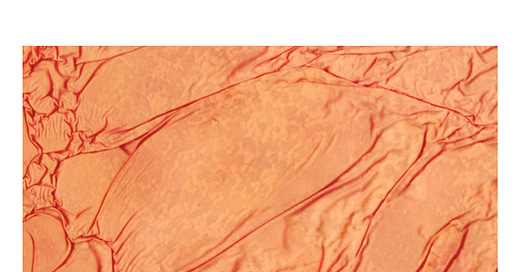



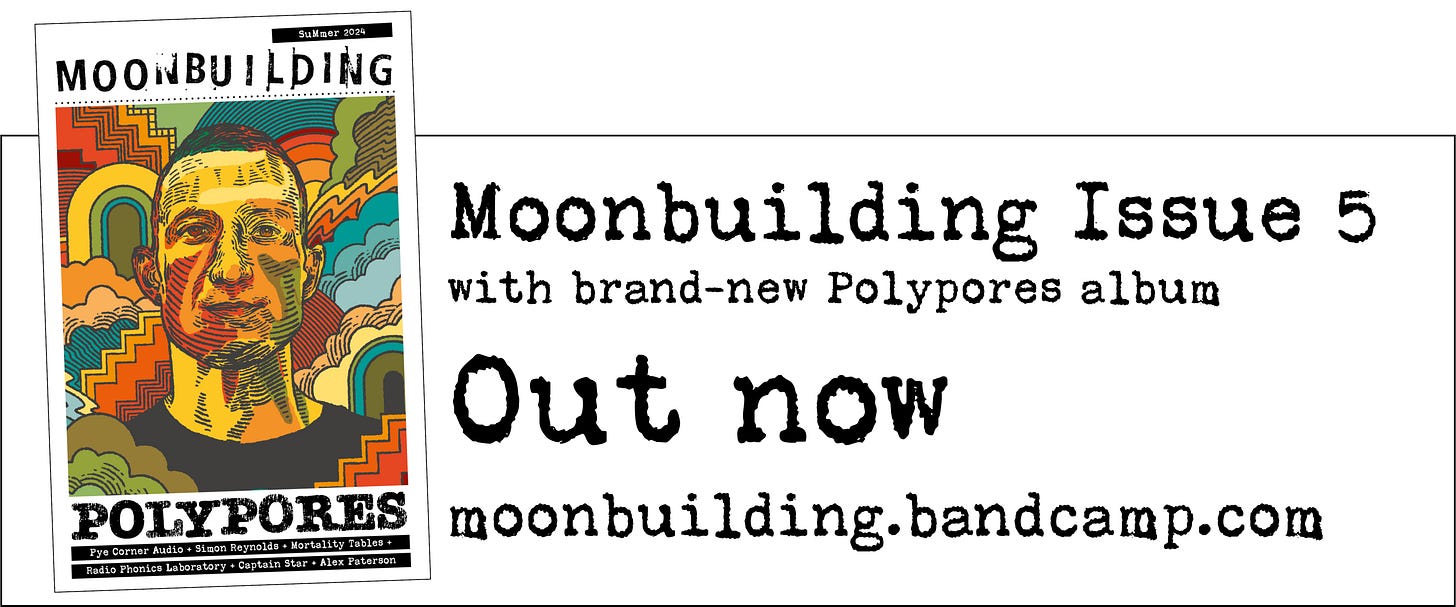

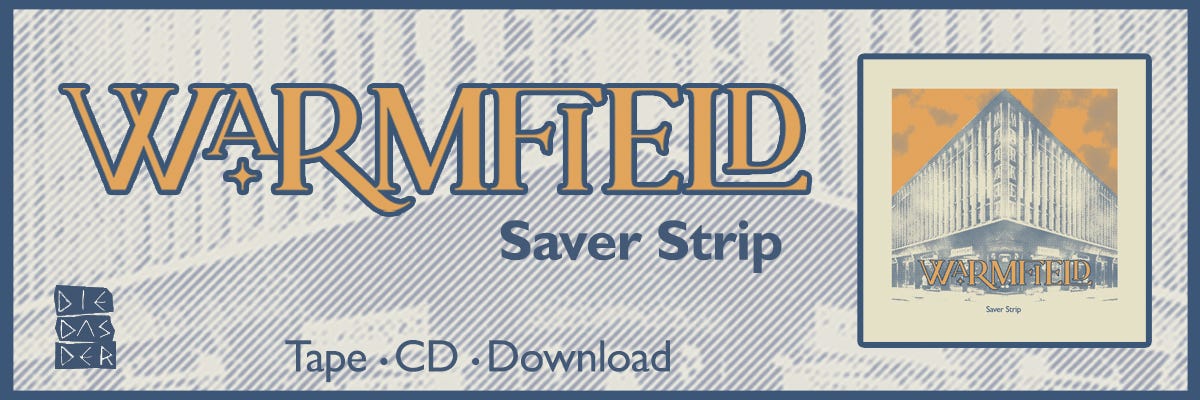

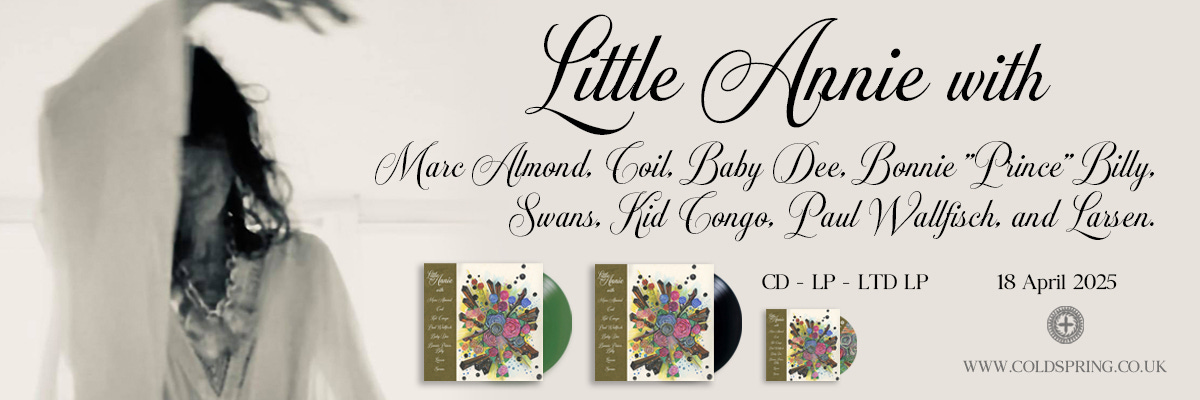

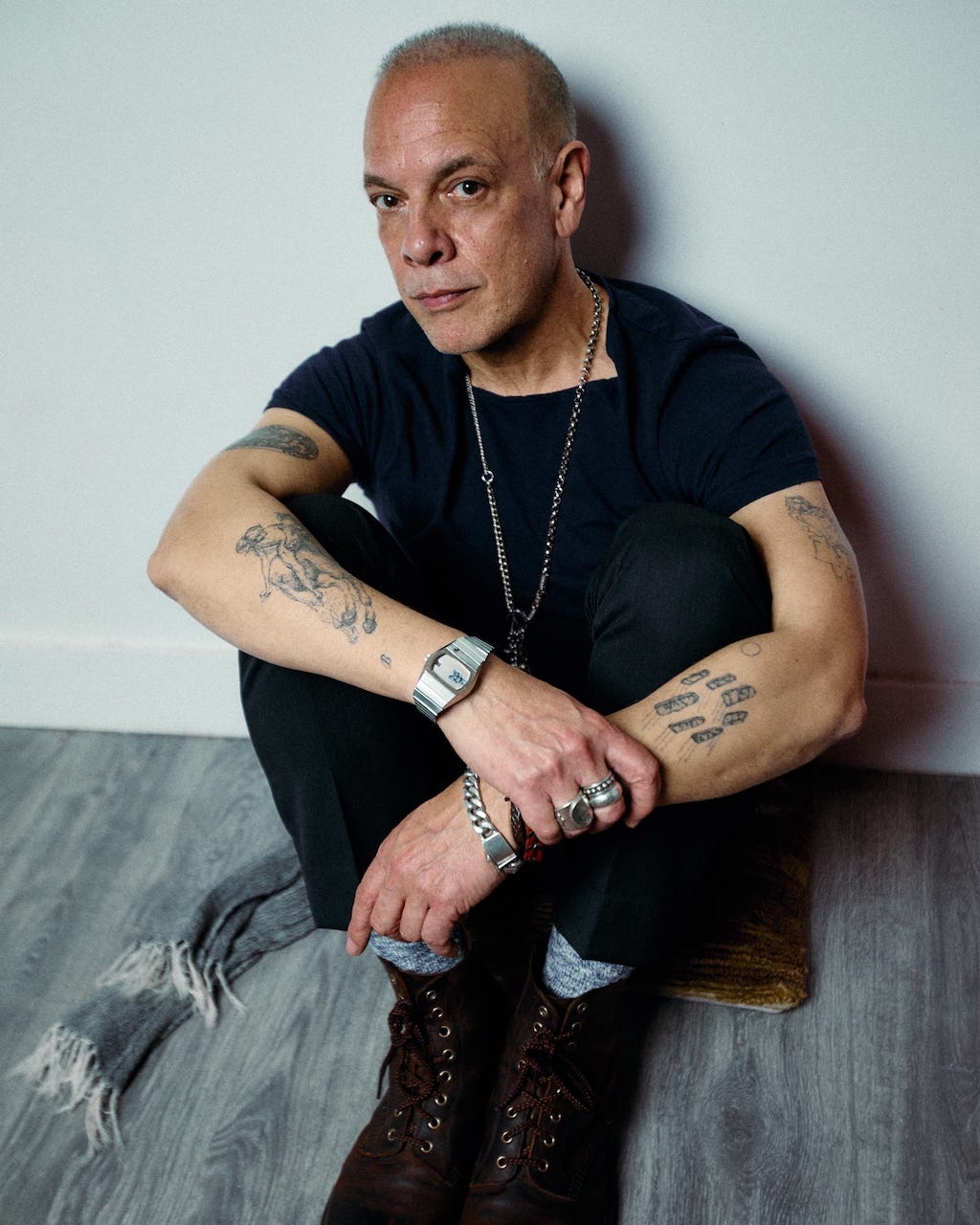

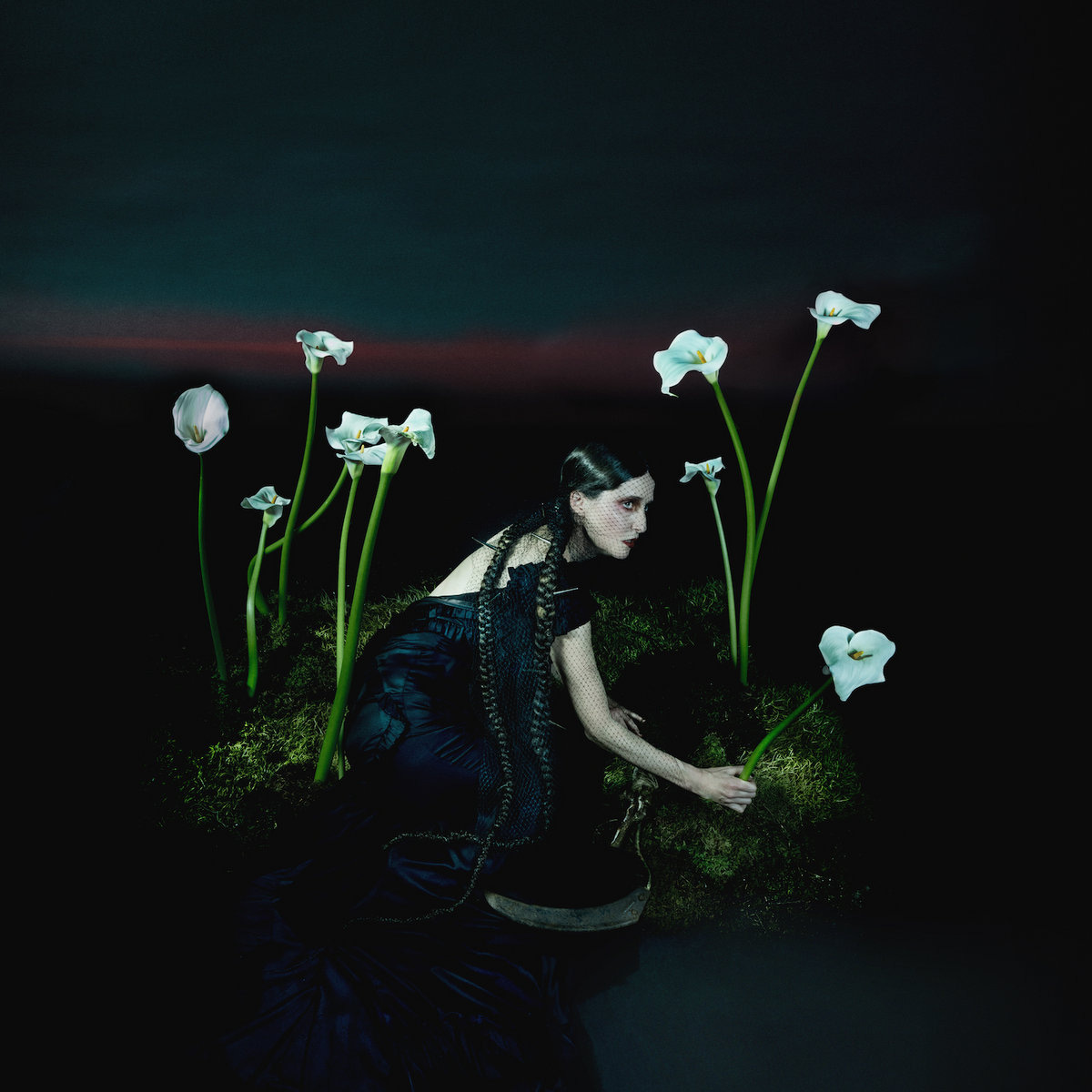
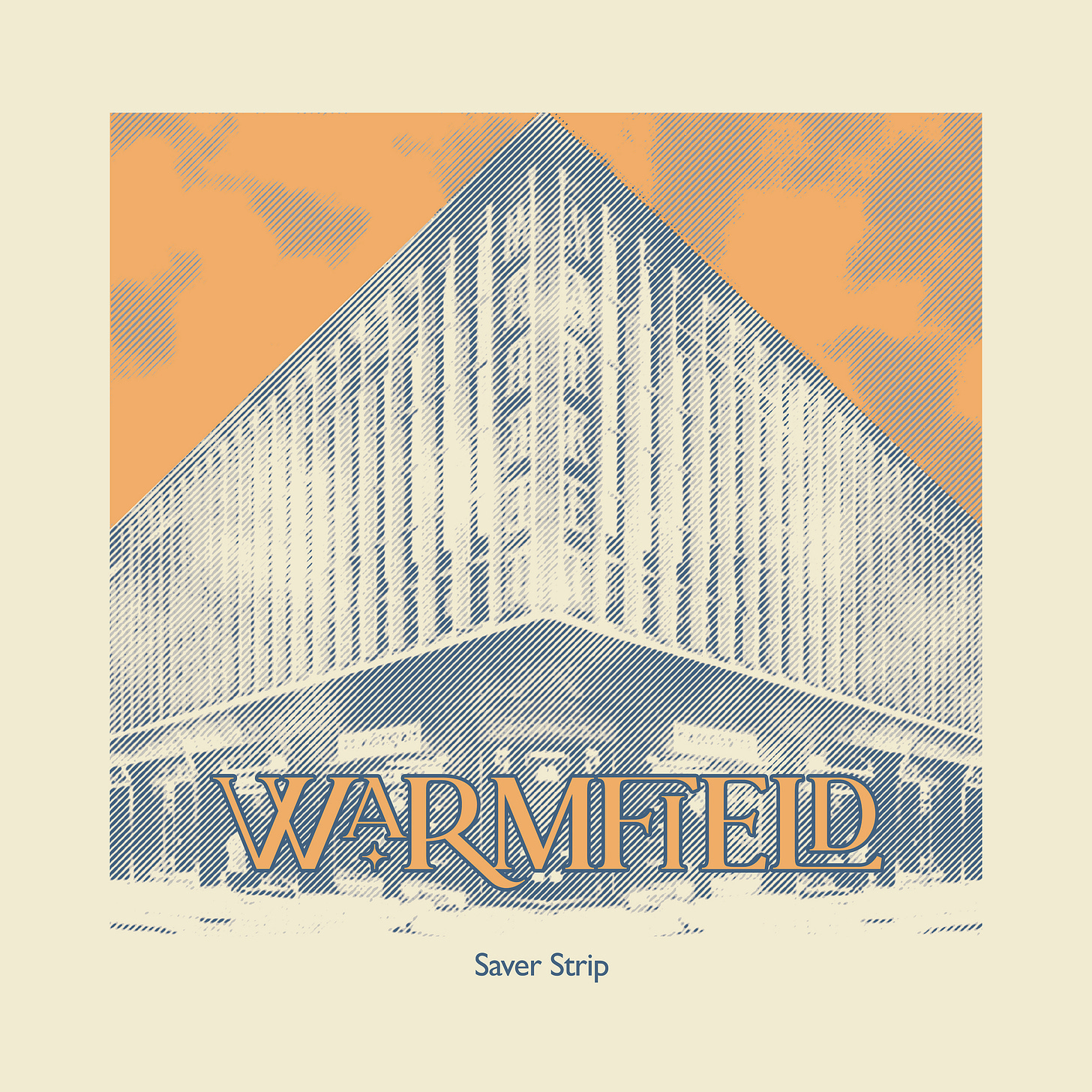


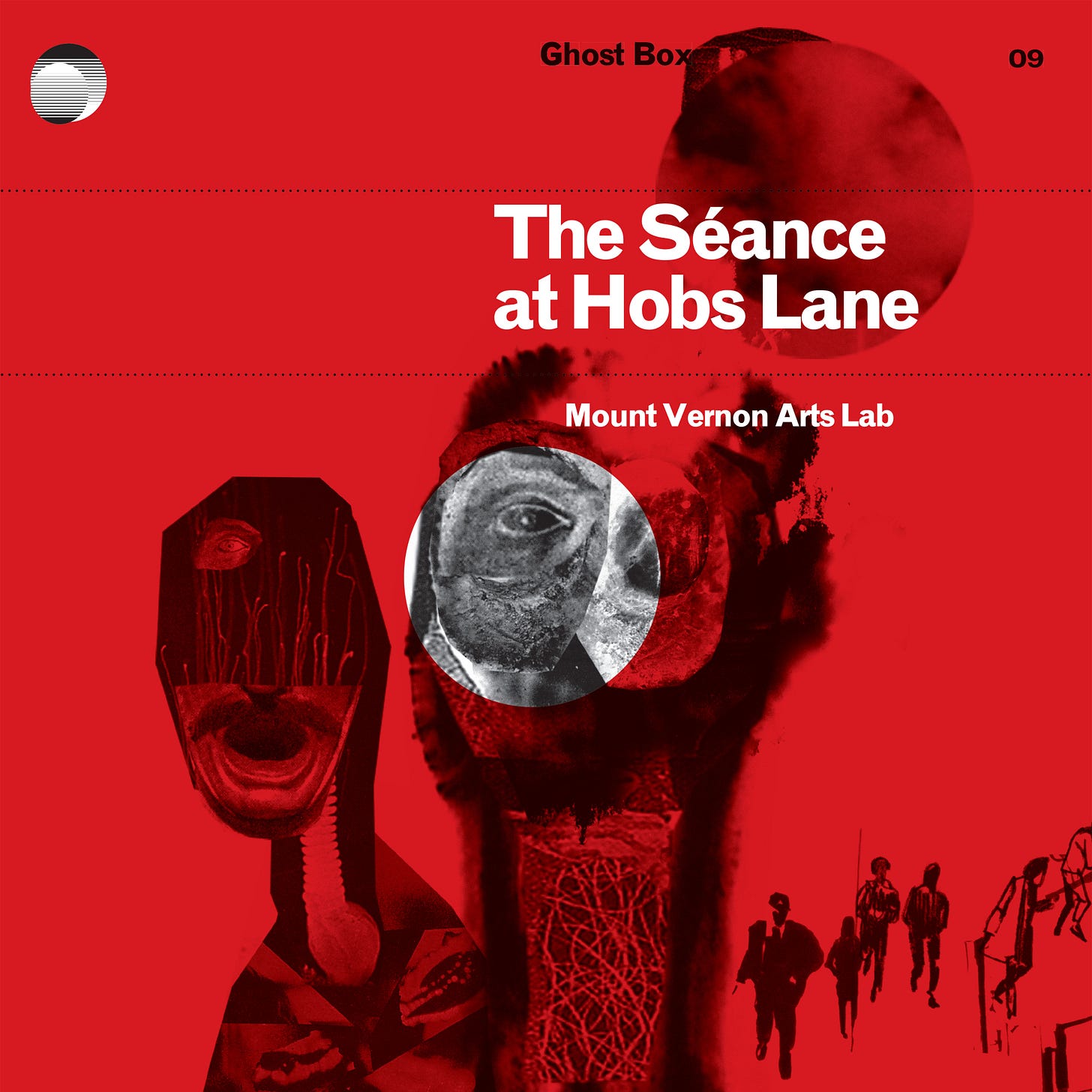
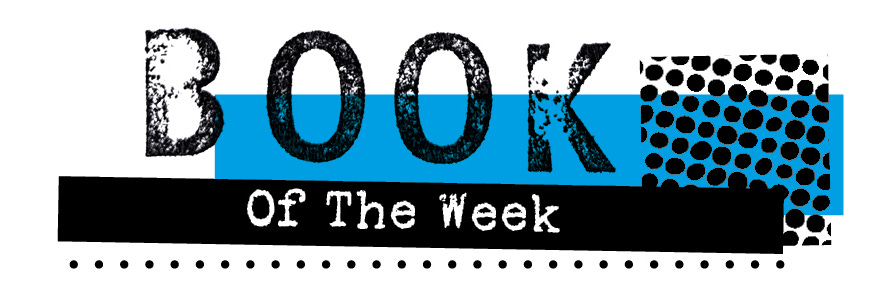
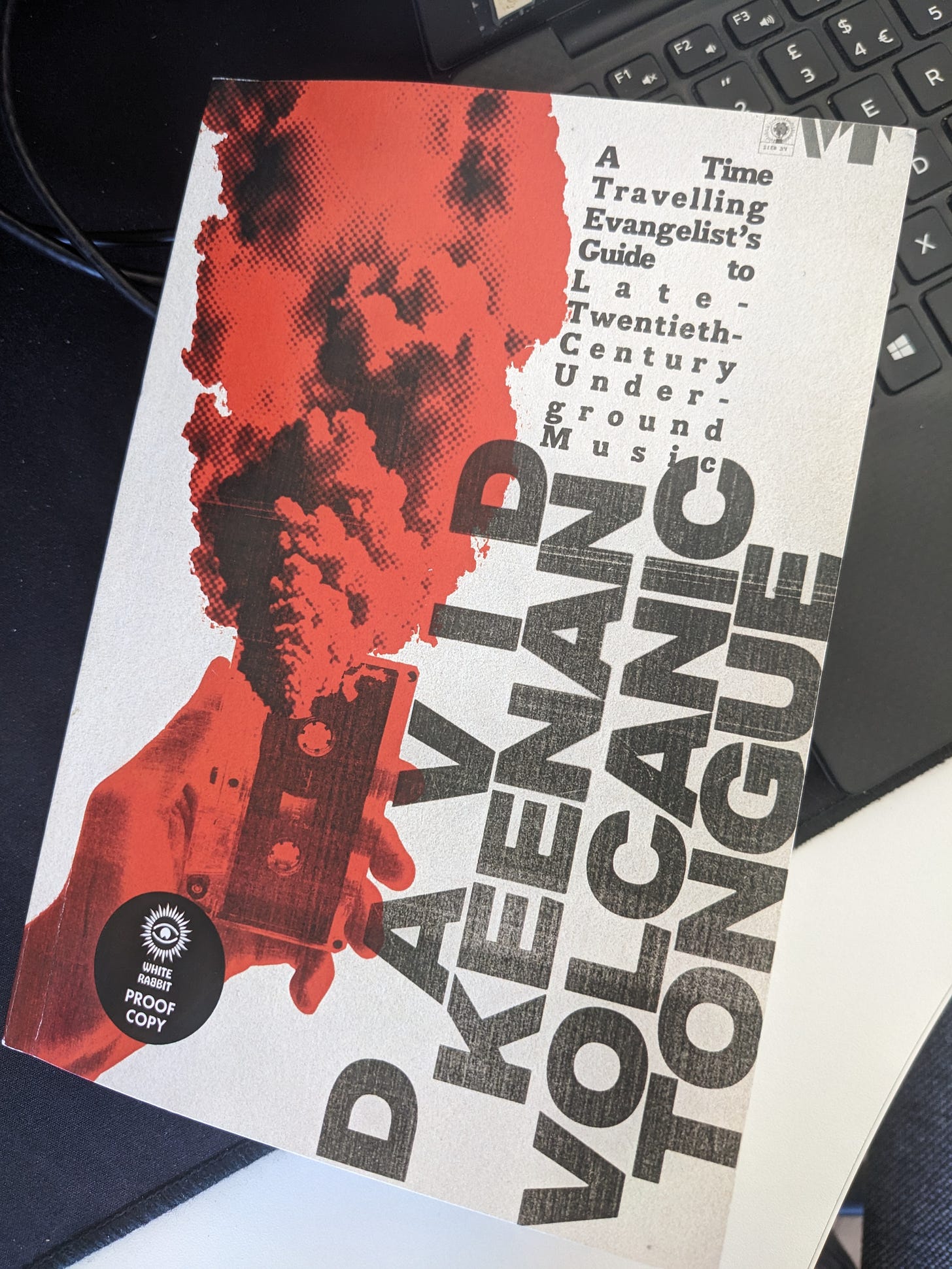

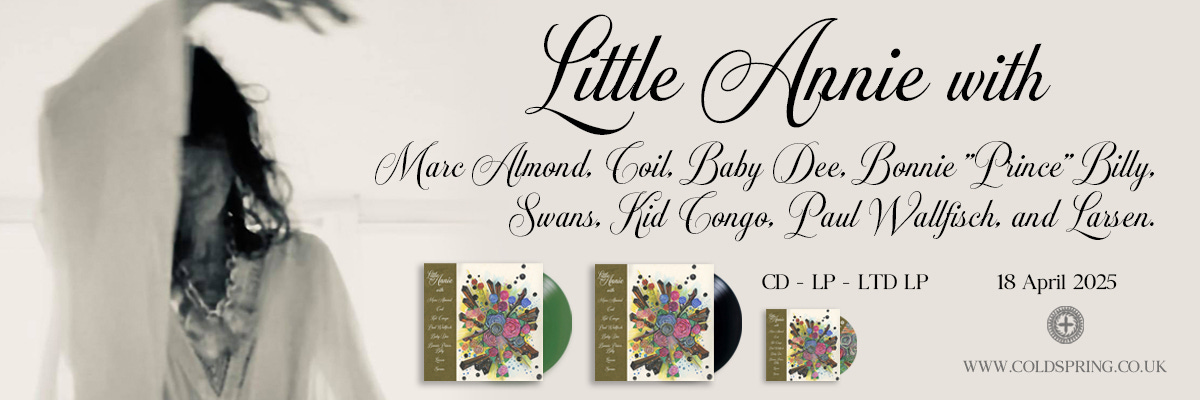
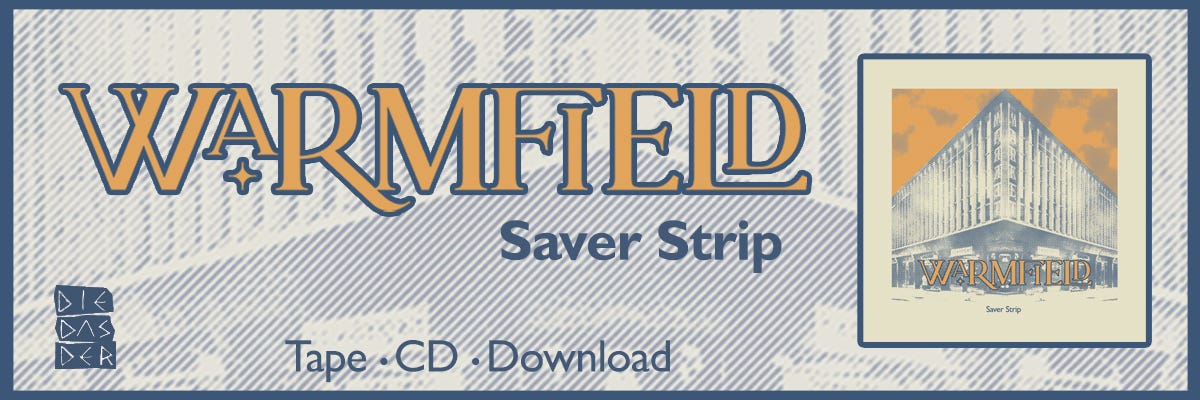


Volcanic tongue is excellent, I've recently produced some lino prints for David's Manifesto of Bliss first 10" lathe cut vinyl release featuring Stephen Clarke...
https://manifestoofbliss.bandcamp.com/merch
There's also a rather nice zine to accompany this and a CD. Worth a gander!
great edition as always neil - big thanks for including qd32 fields we found 🙏🧡